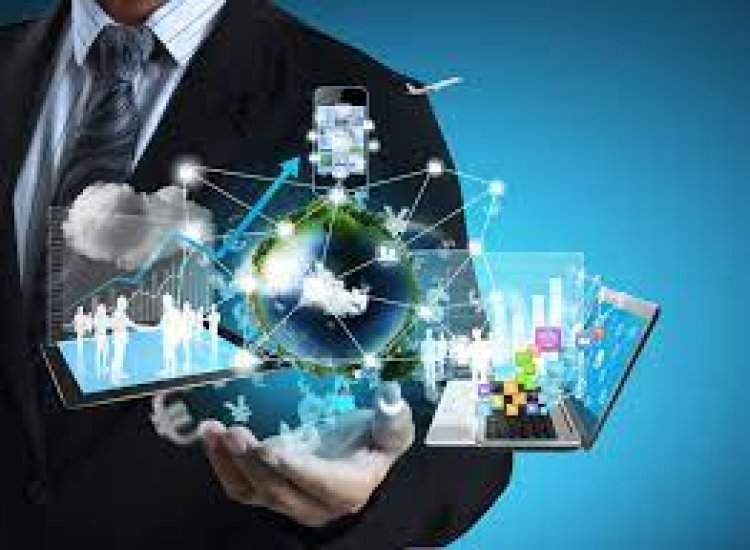Technology
Coverage of the IT sector, including stories on established companies, up-and-coming innovators, and the cultural impact of the web.

What Are The Types of Technology?

The role of technology in our daily lives is becoming important. The past five years have seen more technological advancement than the previous two decades combined. The fast development of technology and its pervasiveness in every facet of modern life beg the questions: what is technology, and what are some of the most recent technical breakthroughs?
Technology is the application of scientific knowledge to improve the efficiency and effectiveness of various tasks. Numerous technologies across several disciplines are being heralded for their potential impact. A plethora of technologies, their significance, and the ways in which they simplify daily life are discussed below.
Use Simplilearn's carefully designed IIT Courses to boost your chances of success on the IIT admission tests. Get the upper hand you need to succeed.
Types of Technology
1. Artificial Intelligence
AI refers to the ability of computers and other technology to mimic human intellect in order to carry out complex tasks that would otherwise be handled by humans.
Siri, Google Assistant, and Amazon's Alexa are all instances of artificial intelligence that are widely used today. Researchers are always working to bring AI technology closer in functionality to human intelligence.
2. Information Technology
The term "Information Technology" (IT) refers to the practice of utilizing computer systems (including hardware and software) and communications networks to record, transmit, and retrieve data. This technology is used to simplify and improve many aspects of running a business.
Software for tracking performance, programs for organizing content, and communication devices like phones and radios are all examples of useful information technology.
3. Space Technology
When it comes to space research, space travel, and Earth observation, space technology is a crucial subfield for scientists to master. Its primary functions are to aid in interplanetary communication and navigation, as well as to facilitate extraterrestrial human endeavors.
Some of the most important contributions of space technology to make space exploration possible are telescopes, GPS systems, radio and imaging, space traffic management, and low-Earth orbit satellites.
Read Also:Master Degree Programs 2024
4. Entertainment Technology
The purpose of entertainment technology is to enhance users' entertainment-related experiences through the application of scientific and technological principles. Television, video games, advertising, streaming services, animation, etc. are just some of the sectors it serves.
The terms "virtual reality," "augmented reality," "interactive environments," "automation," "simulations," and "audio-visual areas" all refer to different forms of entertainment technology.
5. Medical Technology
Pharmacological implications aside, medical technology allows for more precise and timely health evaluations, diagnoses, and treatments.
Robotic surgery, therapeutic gadgets, biometrics, and diagnostic imaging are just a few examples of the ways in which medical technology has made significant contributions to the healthcare sector.
6. Operational Technology
Commonly abbreviated as "OT," operational technology refers to the use of computers and other electronic devices to monitor and manage the safety of production facilities. The operations, equipment, and events of industrial networks can be tracked, controlled, and detected with the use of this technology.
There are several examples of operational technology that can be used to industrial and building equipment, such as fire control systems, physical access control mechanisms, and building management systems.
7. Assistive Technology
Bathing, walking, hearing, mobility, and navigating staircases are just some of the many daily tasks that are facilitated by assistive technology. People with impairments stand to benefit the most from this technology, which was developed with that goal in mind.
Artificial limbs and arms, wheelchairs, walkers, and crutches are some of the most ubiquitous assistive technology.
8. Communication Technology
Communication technology, a hybrid of information and communication, facilitates the exchange of data in the form of messages between electronic devices and human beings. It aids in making decisions and finding solutions to difficulties in individuals.
Virtual assistants, social media sites, Wi-Fi, and Bluetooth are all examples of contemporary advancements in the field of communication technology.
9. Hospitality Technology
This software and networking architecture helps improve customer service in the hospitality industry. It can be used in a number of settings to improve the quality of service provided to customers from a distance, including reservation taking, machine translation, and language learning.
10. Superintelligence
Superintelligence refers to the employment of AI and other computerized systems for the benefit of humankind. Many tasks that previously required human intervention are now performed by this technology instead. Superintelligence manifests itself in a variety of forms; chatbots, virtual agents, and self-driving automobiles are just a few examples.
11. Business Technology
Business technology refers to the use of scientific and technological methods to significantly improve operational efficiencies in commercial enterprises. Information technology, digital marketing, data management, and E-commerce technology are just a few of the many aspects of corporate management that will be affected by this technology.
12. Agriculture Technology
Many labor-intensive and time-consuming manual agricultural tasks are being replaced by scientifically informed technological solutions. Modern agricultural technology, such as temperature and moisture regulation machinery and GPS technologies, is commonly available to farmers who manage and produce crops on a large scale.
13. Robotics Technology
Robotics technology is the branch of engineering and computer science that deals with the creation of tools and programs for making smart robots. Such robots have found use in many other fields as well. Medical robotics is one field that could greatly benefit from this technology's widespread adoption.
14. Educational Technology
EdTech, short for "educational technology," has made significant strides in the classroom with innovations like online courses, multimedia presentations, and gamified learning environments. The primary goal of educational technology is to enhance the learning process by substituting or supplementing conventional methods with those based in science and technology.
15. Product and Food Technology
The goal of product and food technology is to streamline and mechanize as many aspects of the food manufacturing process as possible, which is especially useful for companies that produce food on a large scale. Thanks to advancements in food product technology, the manufacture of a wide variety of edible goods now relies on a wide range of different machines.
16. Architecture Technology
These days, architects do more than just draw plans for buildings. Sustainable architecture encompasses a wide range of concepts, including green architecture, space-saving methods, and more. In addition to facilitating the more traditional steps in the design process, advancements in architectural technology have also helped architects better comprehend the interplay between geographical factors and design details when developing environmentally friendly and functional prototypes.
Building information modeling (BIM), visualisations, generative design, 3D printing and the internet of things are all instances of architecture technology.
17. Construction Technology
Construction technology, or the use of computing systems and software for building, has revolutionized the business. Drones, virtual reality, data collection apps, and other kinds of AI to automate certain operations are all examples of construction technology, which shares some ground with architecture technology.
18. Blockchain Technology
The blockchain is an online financial system that uses cryptography to secure financial transactions. Despite its origins in the management of digital assets, this technology is now also being employed in the development of apps for social networking and online stock markets.
19. Aerospace Technology
Space travel, aerospace engineering, and aircraft design are just a few of the many fields that benefit from aerospace technology. More efficient parts, such wings for spaceships and airplanes, can now be designed with this technology's help, opening up new possibilities for the application of space technology.
20. Environmental Technology
Conservation of resources and our ecosystem has become an urgent need, and as a result, environmental technology—the application of scientific understanding and methods to environmental improvement—has garnered a lot of attention. Wind turbines, solar panels, wastewater purification systems, and photovoltaics are all examples of environmental technology.
21. Biotechnology
Biotechnology is the study and application of using living organisms in the manufacturing process. It uses biological principles and processes like biochemistry and cell biology to create innovative tools. In theory, biotechnology should make our lives better. Genetic engineering, stem cell research, tissue engineering, gene therapy, cloning, and transgenesis are all examples of current biotechnology.
22. Vehicle Technology
Technology related to vehicles includes vehicle development, in which the mechanical components of vehicles and aircraft are periodically modified to increase efficiency. In addition to improving ride quality, reducing carbon emissions is another goal. Parking sensors, collision avoidance systems, and, most recently, self-driving cars are just a few of the major technological advancements in the automotive industry.
23. Forensic Science Technology
With the help of scientific knowledge about the pieces of evidence, forensic science technology has become an essential area to bring greater precision to criminal justice. Some of the most impressive developments in forensic science technology include fingerprint analysis, DNA profiling, and facial reconstruction.
24. Military Technology
The goal of technological advancements in the military is to provide service members with more effective instruments of war. Nuclear weapons, radar technology, and cutting-edge firearms and missiles are just a few examples of the technological improvements that have resulted from countries' efforts to outpower one another and the money they've spent on doing so.
25. Sports Technology
In order to improve athletic performance, sports technologists use their scientific acumen to the development of new tools and equipment. Thanks to technological advancements, sports have been able to adopt cutting-edge methods of training and create more optimal arenas for competition. In the realm of sports, some of the most widely adopted and widely used technologies include video assistant referees, flying drones, camera movements, and edge detectors.
26. Electrical Engineering Technology
When applied to the design, installation, operation, and maintenance of electrical systems, the concepts of science and electrical engineering can yield significant improvements. Transmission lines, light fixtures, power plant generators, microsensors, and nanosensors are just few of the products of EET.
27. 3D Printing Technology
Printing three-dimensional objects is now feasible and efficient thanks to 3D printing technology. CAD software is one of the most well-known tools for this purpose because it allows users to sketch an object before sending the data to a printer to materialize it.
28. Quantum Technology
Quantum technology, a branch of physics, has many practical uses. Some examples include quantum computing, modeling, metrology, and cryptography as well as electric and magnetic sensors and communication technologies.
29. Industrial and Manufacturing Technology
This branch of engineering applies scientific methods to the improvement of manufacturing and industrial processes. Automated machinery, huge and efficient furnaces, conveyor belt systems, and computer numerical control (CNC) milling machines are only some of the common technological advances in this field.
30. Marine Technology
Marine technology contributes to the development of cutting-edge tools for protecting, exploring, and modifying the ocean. Some of the most popular cutting-edge marine technologies today include digital ship route management, integrated control systems, smart defensive technology, and the Internet of Things (IoT) on ships.
Conclusion
I hope you found this post helpful in learning more about the various technological options available. We think Simplilearn's Post Graduate Program in Full Stack Development is the best option if you want to advance your career in software development. You can improve your technological and development abilities through this program designed in tandem with Caltech CTME.
Please use the space below to ask any questions or make any comments you may have. As soon as possible, someone from our team will get back to you.













